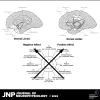Neurophysiological mechanisms of implicit and explicit memory in the process of consciousness
- PMID: 36044682
- PMCID: PMC9576178
- DOI: 10.1152/jn.00328.2022
Neurophysiological mechanisms of implicit and explicit memory in the process of consciousness
Abstract
Neurophysiological mechanisms are increasingly understood to constitute the foundations of human conscious experience. These include the capacity for ongoing memory, achieved through a hierarchy of reentrant cross-laminar connections across limbic, heteromodal, unimodal, and primary cortices. The neurophysiological mechanisms of consciousness also include the capacity for volitional direction of attention to the ongoing cognitive process, through a reentrant fronto-thalamo-cortical network regulation of the inhibitory thalamic reticular nucleus. More elusive is the way that discrete objects of subjective experience, such as the color of deep blue or the sound of middle C, could be generated by neural mechanisms. Explaining such ineffable qualities of subjective experience is what Chalmers has called "the hard problem of consciousness," which has divided modern neuroscientists and philosophers alike. We propose that insight into the appearance of the hard problem can be gained through integrating classical phenomenological studies of experience with recent progress in the differential neurophysiology of consolidating explicit versus implicit memory. Although the achievement of consciousness, once it is reflected upon, becomes explicit, the underlying process of generating consciousness, through neurophysiological mechanisms, is largely implicit. Studying the neurophysiological mechanisms of adaptive implicit memory, including brain stem, limbic, and thalamic regulation of neocortical representations, may lead to a more extended phenomenological understanding of both the neurophysiological process and the subjective experience of consciousness.NEW & NOTEWORTHY The process of consciousness, generating the qualia that may appear to be irreducible qualities of experience, can be understood to arise from neurophysiological mechanisms of memory. Implicit memory, organized by the lemnothalamic brain stem projections and dorsal limbic consolidation in REM sleep, supports the unconscious field and the quasi-conscious fringe of current awareness. Explicit memory, organized by the collothalamic midbrain projections and ventral limbic consolidation of NREM sleep, supports the focal objects of consciousness.
Keywords: collothalamic; consciousness; lemnothalamic; memory; phenomenology.
Conflict of interest statement
No conflicts of interest, financial or otherwise, are declared by the authors.
Figures




References
-
- Tucker DM, Luu P. Cognition and Neural Development. New York: Oxford University Press, 2012.
Publication types
MeSH terms
LinkOut - more resources
Full Text Sources
Medical

